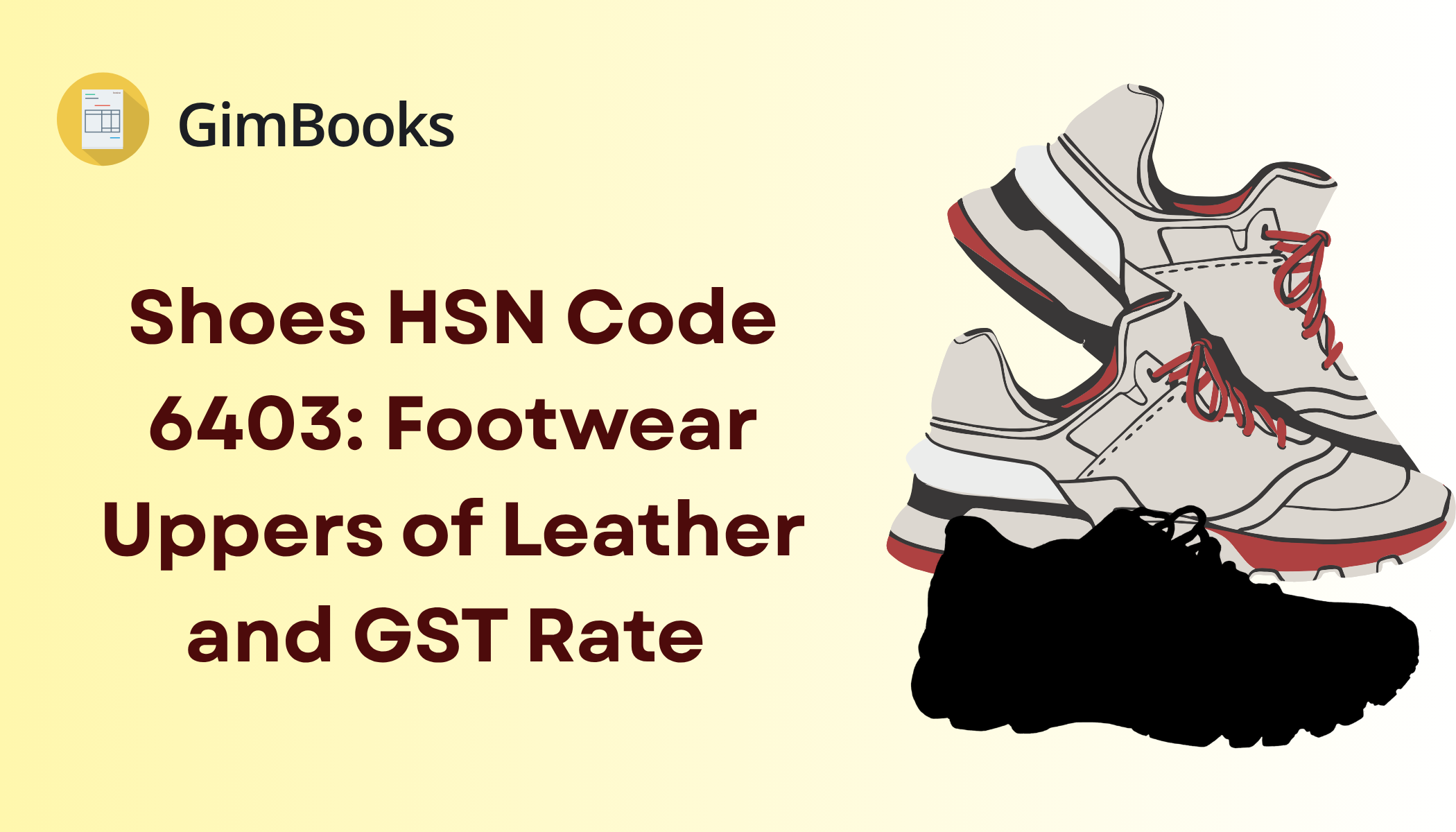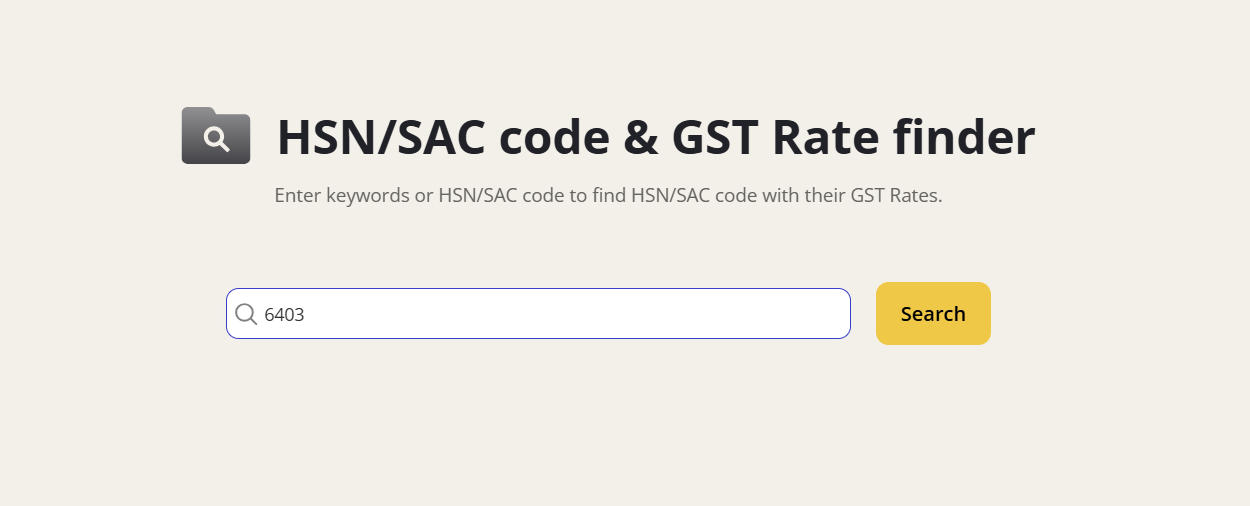Shoes HSN Code 6403: Footwear Uppers of Leather and GST Rate

Understanding the 6403 HSN Code is essential for footwear manufacturers, retailers, and traders dealing in leather products. The 6403 HSN Code GST rate applies to footwear with leather uppers and soles made of rubber, plastic, or composition leather. Knowing the correct classification ensures accurate tax filing, compliance, and smooth business operations in the footwear industry. In this guide, we’ll break down what HSN Code 6403 covers, its GST rate, and how it impacts footwear businesses in India.
What is HSN Code 6403?
HSN Code 6403 covers “Footwear with outer soles of rubber, plastics, leather, or composition leather and uppers of leather.” It includes all types of leather and synthetic footwear—like formal shoes, boots, sandals, and chappals—with leather uppers.This classification is primarily used by shoe retailers, leather manufacturers, wholesalers, and footwear brands to correctly apply GST rates for compliant billing.
GST Rates & Exemptions for HSN Code 6403
As per the latest GST updates (effective 22 September 2025), footwear pricing determines the rate slab applicable under HSN Code 6403. The GST Council simplified earlier 12% and 18% slabs into a two-tier rate structure to encourage affordable footwear access.
Updated Footwear GST Structure (2025)
This price-based structure ensures lower taxes on everyday shoes while maintaining standard rates for luxury and high-end footwear. Earlier, the threshold of ₹1,000 was increased to ₹2,500 to boost affordability in rural and semi-urban markets.
Table Notes
- The ₹2,500 threshold applies to the retail sale price per pair (exclusive of GST).
- Footwear parts like soles, heels, and uppers have a flat GST rate of 18%, irrespective of final footwear price.
- There is no compensation cess applicable on footwear.
- Both leather and synthetic variations are included under the same HSN classification, but rate differences may arise by product cost.
GST Rates Applicable Under 6403
(Rates reflect applicable brackets below or above ₹2,500 per pair.)
What’s Included in HSN 6403 Footwear?
HSN 6403 encompasses all footwear where the upper is leather and soles are made of rubber, plastic, or composition leather. It includes:
- Formal & casual leather shoes (men/women/children)
- Boots & safety shoes
- Kolhapuri & handcrafted slippers
- Leather sandals & chappals
- Sports and outdoor footwear with leather finishes
Leather accessories and parts used in footwear manufacturing, like straps and uppers, also fall under this category but are taxed differently at the flat 18% rate.

Explore Gimbooks HSN/SAC code & GST Rate finder
Key Exemptions Under GST for Footwear
- Footwear priced below ₹2,500 per pair enjoys 5% GST (essential category).
- Handmade or traditional leather chappals (e.g., Kolhapuri) may qualify for special consideration under the 5% bracket, subject to turnover and price.
- No broad exemptions apply to branded or synthetic footwear above ₹2,500 per pair.
- Raw materials like EVA soles or adhesives may attract higher GST (12–18%) under input classifications.
Input Tax Credit (ITC) Rules for Footwear
Registered footwear businesses can claim Input Tax Credit (ITC) on:
- Raw materials (rubber, leather, adhesives, soles)
- Components (heels, buckles, insoles, laces)
- Transport and packaging services
ITC Eligibility Conditions:
- Footwear must be sold under a taxable rate (5% or 18%); ITC cannot be claimed for exempted goods.
- Proper GST invoices and supplier registration are mandatory for credit claims.
- Manufacturers producing both low-cost (5%) and premium (18%) shoes should maintain distinct input accounts for accurate credit filing.
GST on Footwear Billing: Practical Scenarios
- A retail outlet selling leather sandals at ₹2,000 per pair charges 5% GST.
- A luxury brand pricing shoes at ₹4,000 per pair applies 18% GST.
- A footwear manufacturing company bills imported leather parts at 18% GST but claims ITC against final taxable sales.
- An online seller listing ₹2,499 footwear remains under the 5% bracket; ₹2,501 triggers 18%.
Common Mistakes in Footwear GST Compliance
- Misclassifying rubber/plastic footwear under leather codes (6403 vs 6401/6402).
- Charging flat 18% on all footwear despite price brackets.
- Missing ITC documentation for input parts or misusing credits for non-taxable categories.
- Not revising GST invoicing systems post the 2025 rate reform.
Conclusion
HSN Code 6403 ensures simplified GST compliance for footwear uppers made of leather across both everyday and luxury segments. Under GST 2.0 reforms (effective 22 September 2025), affordable footwear up to ₹2,500 attracts just 5% GST, while premium or designer models are taxed at 18%. Correct classification and consistent documentation help footwear manufacturers, wholesalers, and retailers maintain compliance and cost efficiency in 2025.
Also explore
- Cloth HSN Code 5208
- LED Light HSN Code 9405
- Glass HSN Code 7005
- Bricks HSN Code 6901
- T Shirt HSN Code 6109
FAQs: HSN Code 6403 & Footwear GST
What is HSN 6403?
It refers to footwear with outer soles of rubber, plastics, or leather and uppers made of leather, including shoes, boots, sandals, and slippers.
What’s the GST rate for shoes under HSN 6403?
Footwear up to ₹2,500 per pair attracts 5% GST; above ₹2,500 is taxed at 18%.
Are handcrafted or traditional footwear exempt from GST?
Traditional leather chappals like Kolhapuri are taxed at 5%, subject to price and category; full exemption doesn’t apply.
Can footwear manufacturers claim ITC?
Yes, ITC is available on leather, soles, adhesives, and other input materials if footwear is supplied under taxable rates.
What are common errors to avoid in footwear billing?
Applying flat 18% GST on all shoes or using the wrong HSN sub-code for materials and pricing are common compliance mistakes.
What is the tax rate for HSN Code 6403?
The GST rate for products under HSN Code 6403 (footwear with leather uppers and rubber, plastic, or leather soles) is typically 18%, though footwear priced below a specific threshold may attract a lower rate. Always verify the latest GST notifications for updates.
What is the HSN Code 64023090?
HSN Code 64023090 covers other footwear with outer soles made of rubber, plastics, leather, or composition leather and uppers made of leather, not specifically mentioned elsewhere. It generally applies to various types of leather shoes and boots.
What is HS Code 6403?
HS Code 6403 refers to “Footwear with outer soles of rubber, plastics, leather, or composition leather and uppers of leather.” This includes leather formal shoes, boots, sandals, and similar footwear.
